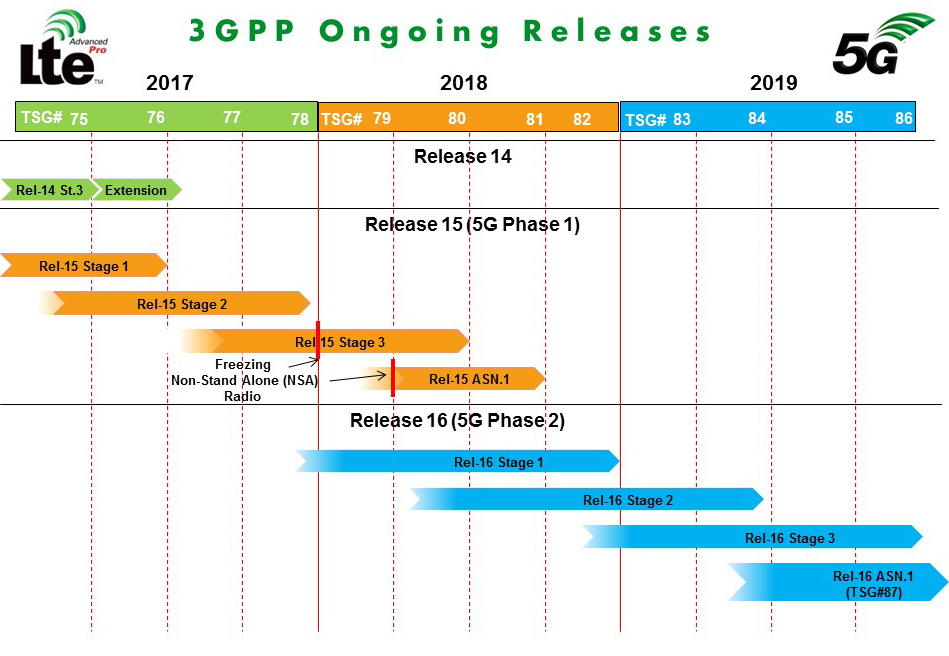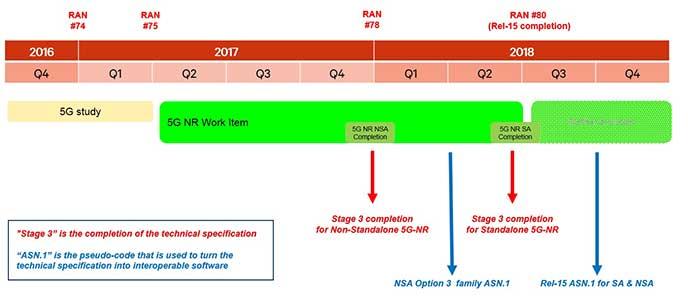Some time left but lot of people are talking about 5G. Theoretically it will be available in the year 2020 but, will it really be available? 3GPP organisation, the one in charge of mobile network standardisation, has publish its plan for the first 5G version.
Although numbers from 75 to 86 are corresponding to meetings and not quarters, we could realise release 15, the first version including 5G standard, will be available in 2018.
This first 5G version is named NSA or “Non Stand Alone”. This means 5G deployment will be based on current 4G infrastructure. Network architecture will be the same and mobile network antennas will offer a new band using 5G radio technology providing higher capacity. From the antenna data traffic is managed in the same way 4G data is done.
Next 5G version or 5G “Stand Alone” will be available in the same release 15 but a bit later. In 5G SA network architecture will be the one designed for 5G and not current 4G one. This change allow to provide new 5G services not possible over 4G architecture.
5G NSA specification will be “frozen” in early 2018 and available to be used by equipment manufacturers. Manufacturers will take short time to provide them as they are participating in 3GPP meetings and they fully know 5G specifications.
But, Which are these manufacturers? In one side we have network infrastructure manufacturers. Main ones are Ericsson, Nokia and Huawei. These three manufacturers cover more than 90% of mobile network equipment market share and they are the reference companies.
In the other side mobile processor manufacturers for mobile devices. Market is more concentrated even as reference manufacturer is Qualcomm. Qualcomm cover almost 50% of market share and license most of the other ones. Qualcomm vision is as follows:
It appears 5G will be available in 2018 and mass deployment will depend on the effort of manufacturers, network operators and governments as well. Qualcomm has published its Qualcomm Snapdragon X50 5G mobile processor supporting from 2G to 5G will be available for massive deployment in 2019. This mobile processor supports not only current bands (under 6 GHz) but the new “millimetre” bands in 28 GHz and 39 GHz.
So we release that, far from being delayed, we could expect shortly the new mobile network generation. But, what could we expect from 5G? Additionally to higher connection speeds 5G offer new services classified in 4 categories:
- Massive IoT. 5G fully support “Internet of the Things” which means a huge increased of connected devices. Inside this category services like Smart Home, Smart Cities, Smart Utilities (Electricity, Gas, Water) and eHealth (Medical Applications) are included.
- Critical Communications. The main areas where improvements are needed are latency, reliability, and availability to enable, for example, industrial control applications and tactile Internet. These requirements can be met with an improved radio interface, optimised architecture, and dedicated core and radio resources.
- Enhanced Mobile Broadband. It includes a number of different use case families related to higher data rates, higher density, deployment and coverage, higher user mobility, devices with highly variable user data rates, fixed mobile convergence, and small-cell deployments.
- Network Operation. It addresses the functional system requirements, including aspects such as: flexible functions and capabilities, new value creation, migration and inter-working, optimisations and enhancements, and security
We could see year 2020 won’t be the year of a restricted launch of some 5G equipments. It is expected 5G will be working and fully available in most countries.








